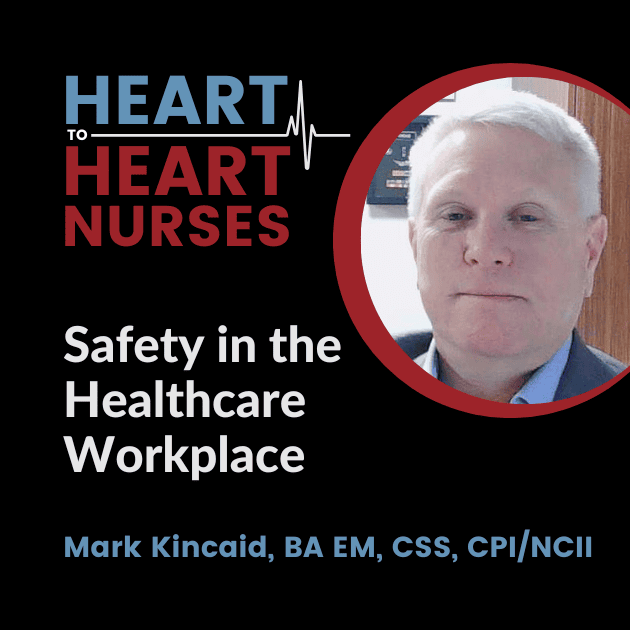Workplace safety impacts healthcare employees, patients and family members. Guest Mark Kincaid, BA EM, CSS, CPI/NCII, describes strategies including de-escalation that can be applied in any setting.
Episode Resources
Welcome to Heart to Heart Nurses, brought to you by the Preventive Cardiovascular Nurses Association. PCNA’s mission is to promote nurses as leaders in cardiovascular disease prevention and management.
Geralyn Warfield (host): Welcome to today’s episode of our Heart to Heart Nurses podcast. And we have the great pleasure of speaking with Mark Kincaid. Mark, could you introduce yourself to our audience please?
Mark Kincaid (guest): Yes, good afternoon. I’m Mark Kincaid. I am the Security Manager for Orlando Health Regional Medical Center here in Orlando, Florida.
Geralyn Warfield (host): And we’re here to talk about something that’s very important and not something that’s easy to discuss. And that is how the workplace for healthcare professionals has changed dramatically over the years. And there’s a real need to be aware of and plan for workplace violence. I’m hoping you could tell us a little bit more about that.
Mark Kincaid (guest): Sure. Workplace [00:01:00] violence is a situation in which the healthcare industry in particular, but workplaces around the country, globally, are becoming more and more attuned to. Healthcare professionals occupy the highest percentage of workplace violence incidences in the country.
And that’s to be expected. You’re working in a facility, you’re providing care to people that generally don’t want to be in that environment, that nobody wants to come to the hospital generally, particularly as a patient.
And so, our healthcare professionals working the front lines, the dedicated men and women of our healthcare professionals, are bearing the brunt of a lot of our workplace violence issues.
So, within the healthcare facility, and particularly within Orlando Health, as an organization we’ve really taken the charge and stepped up to work in the forefront of establishing safer work environment for [00:02:00] our clinicians, for our nurses, for our security personnel who are in partnership with them, to help make safer places for our workplace partners.
Geralyn Warfield (host): And I realize this is a very complex topic. And it varies from facility to facility and location to location in terms of what kind of support mechanisms are in place. But could you go through maybe some of the major areas, we probably know them, but the major areas that are sources of workplace violence.
Is it sometimes peer to peer? Is it patient and family against a healthcare professional? What kind of general categories are you seeing at your facility or not even at your facility, but just in the industry overall?
Mark Kincaid (guest): Sure. Obviously, workplace violence impacts our healthcare professionals, our employees, our team members, in a variety of different ways and stem from a variety of different nexuses, different causes.
However, the vast majority, the data that I’ve collected over the last few years within my organization [00:03:00] has shown that it is primarily patient to team member, patient to healthcare.
Now, we do get situations where, an episode has occurred off campus at home, and that has followed the team member back into the workplace, at which point then it becomes an issue of workplace violence.
Lower end on the spectrum would be the employee against employee, or maybe even family member or guest against one of the employees. Although those do happen from time to time. those are still relatively low on the percentage scale when we look at the rates, particularly with patient against a team member or a clinician.
Geralyn Warfield (host): So, one of the things from my experience that has helped me in life in general is to do the “What if?” situation or “What if?” scenario. And it’s not meant to be doom and gloom, but it’s meant for you to be looking at your environment, looking at your situation, looking at your [00:04:00] context, and really thinking about the what ifs before anything ever were to happen.
I think with those of us that drive do this, sometimes without thinking. That you are looking out front. You’re looking in the rear-view mirror. You’re looking at the side. And periodically you might be thinking, “Well, what happens if that large vehicle behind me doesn’t decelerate fast enough?”
And so, we kind of do this subconsciously, but I think sometimes we need to do it a little bit more consciously. Would you say that that’s one strategy that clinicians might use? Doesn’t have to happen every moment of every day, but just to consider what might be the next step should something happen?
Mark Kincaid (guest): Sure. Personal safety: safety for the team members as well as our patients, visitors and guests is paramount to the efforts that we’re engaging in to make it a safer workplace for everybody.
But one of the things that we work with our team members is, being aware of their environment, being aware of their surroundings. If they’re dealing with a patient that might [00:05:00] have a history of acting out. and they don’t want to put, say, for example, something between them and the door so they have an emergency way to egress, Having a second pair of hands and eyes in the room with them as a secondary mean of protection and to kind of watch their back for them while they’re engaged in work.
Also very important that we’re finding is really beginning to help drive our work towards creating a safer work environment for our team members is ensuring that our team members, all our clinicians, medical staff, our security officers, those that have the direct hands-on kind of interactions, close quarter interaction with our patients, is to familiarize themselves with a variety of de-escalation techniques.
And learning how to verbally engage with a patient, being able to watch for his visual cues that could be warning indicators. And [00:06:00] what to do if they should find themselves in a situation where a patient has grabbed onto them, or somebody has grabbed onto them—how do they react to that? How do they negotiate their way out of that in a safe and thoughtful manner based on the situation?
So, we take all, all that, kind of throw it in a pot, stir it all up, and out comes some quality, hopefully quality trained individuals within our organization that have the better tools to help keep themselves safe.
Geralyn Warfield (host): I think something that goes alongside that is having policies at the organizational level in terms of the training that you’ve described. I have had cause in the last several years to, you know, visit hospitals or other healthcare settings with family members and have noted the presence of signage that, you know, “We do not accept any acts of violence in our facility here.” And, you know, “Here’s what the ramifications are.” And obviously that’s a lot newer [00:07:00] than when I was a youngster and visiting someone in the hospital.
So, sometimes you’re bringing it front of mind to those people that are coming into contact with our clinicians too, then, aren’t you?
Mark Kincaid (guest): Correct. It it’s part of our engagement with our patients is letting them know, generally by the vast majority of our patients are guests and visitors that come within our facilities are well-mannered folks.
They’re there, they’re under some sort of crisis trauma, whatever the case may be, for their particular situations. And of course, those bring out different emotional reactions to various environmental stimuli, or interpersonal relationships, and contacts that they may have within the facility.
But most of our patients don’t fall into those kind of categories. They come in; they understand that the staff is there to help them. They willingly accept the help from the staff. They’re very grateful for the staff being there and dedicating their lives, and their careers, to betterment of their health.
However, when we do run into those few [00:08:00] patients that might have caused us issues, the medical teams are very apt about engaging with them, along with our administrative teams. And laying out some groundwork—ground rules—for them and letting them know that this kind of conduct is not accepted.
It’s a multifaceted approach, to not only educating those that find themselves within our facility and beyond just our team members. But so, as you said, it’s not necessarily a one-size-fits-all program. You have to be prepared to be mobile, and reactive, in dealing with each individual situation.
Geralyn Warfield (host): We are in conversation with Mark Kincaid. We are going to take a quick break, and we will be right back.
Geralyn Warfield (host): We’re back talking about workplace security for healthcare professionals with our guest at the table today, and that’s Mark Kincaid.
Mark, we were talking right before we came on air today about how your team interacts with the [00:09:00] nursing staff at your facility. Could you tell us a little bit more about what that looks like?
Mark Kincaid (guest): Right. Well, one of the roles that the security department does within our organization is that we partner with our clinician staff, and particularly our nurses, and work with them in understanding and developing good de-escalation techniques.
And one of the things that we try to stress, or one of the things I try to stress as an instructor for the program, is that it’s fundamentally important that we understand that the individuals that we are engaged with are there under crisis.
As I’ve said before, nobody particularly wants to be in a hospital. So, somebody that’s there is already under some sort of crisis, whether it’s an emotional crisis, a physical trauma, emotional trauma, whatever the case may be. And so, they find themselves in a position where their emotions or their attitudes overwhelm them. And unfortunately, it lashes out sometimes.
So, [00:10:00] when I engage with my nursing staff and my colleagues is try to educate them that, remember that it’s called rational detachment. Understand that you’re dealing with somebody in crisis.
And not allowing their behavior to influence your behavior.
Their negative behavior—if you can overcome that, remain rationally detached—will allow you to remain calm (at least give you a better opportunity to do so), remain calm and address the situation in a much more productive manner.
Geralyn Warfield (host): And you also were describing to me how when individuals are coming out of anesthesia, a lot of times that’s where these actions are generated. Could you talk a little bit more about that as well?
Mark Kincaid (guest): Sure. Yes, there is a percentage of cases in which an individual is coming out of anesthesia, say for example. So they’re coming out of anesthesia and they find themselves waking back into a world where they may not remember where they are. They don’t know where they are. There are strange [00:11:00] sounds, strange people that are around them, machines that are going beep, beep, beep, or whatever the case may be.
And so, some folks, when they come out of that, they come out of it in a reactive manner, not necessarily out of any ill intent or in or desire to cause harm to anybody, but it’s more reflexive, more reactionary to the situation.
And sometimes a nurse, or a CNA, or a tech, might be around the patient when they come out of this and a hand goes up or an elbow goes out., or they start to thrash around because they’re in a state of panic for a moment. And I’ve seen our staff deal with those situations that are incredibly good at being able to calm somebody down with that, and reassure them, and get them to, you know, that happy place where they should be.
Geralyn Warfield (host): Excellent. And how do you partner as a security team with…well, what role really does your security team have in de-escalating other workplace violence, types of actions, or what other preparations do you make to help the [00:12:00] clinicians in what they’re doing?
Mark Kincaid (guest): Well, it is one of the responsibilities of the security department is to document and record a variety of incidences, and one of those being workplace violence incidences.
Now, that’s not only to develop a reporting structure so that it could come back to, if legal issues or whatever the case may arise, but also, more importantly, so that we can generate statistical data so that we can go back and see where are we seeing trends at, what kind of trends are we seeing?
And once we have that kind of information, we can then go back and develop programs and focus our attentions in areas that really need them instead of wasting and time and energy in some place where it doesn’t. And that’s proven to be very helpful for us.
Additionally, the security team in the hospital are also there to help protect the employees, the team members of the organization, as well as the patient, themselves as well.
And [00:13:00] so we do that by intervening when it’s a situation in which it has escalated to the point where the staff has had to back out, and allow the security team to come in,
And very rarely, believe it or not, do our security officers need to run in and then just start grabbing somebody, or restraining them to the bed and, doing what we call hard restraints, locking restraints.
Most often by far, because of the skills and the talents of the security team, they can go in there and they can verbally de-escalate the situation.
As a former crisis negotiator for the police department, one of the things that we have learned to do and that I instill upon my officers is that you have all the time in the world generally. Unless there’s some sort of medical emergency that needs to be addressed, we have time to sit there and talk with the individual, to calm them down and get them [00:14:00] to a point where they will accept the care and the help that they need. And that by far, by far, is how most of the engagements go. Absolutely.
Geralyn Warfield (host): Is there anything else that you’d like to add that we have not yet had a chance to discuss?
Mark Kincaid (guest): I would encourage anybody that is working in the healthcare industry, particularly the healthcare industry, is to really step back and take a look at your workplace violence policies, procedures, the culture around that. And instill programs and attitudes within the organization that fosters reporting. Estimates, depending on where you go for your sources, estimates are somewhere in the neighborhood of 80% of workplace violence issues go unreported. Now those can be very minor things, which they usually are.
But most of them go unreported because the staff members do not wish to get themselves in trouble, get somebody else in trouble, get a patient in trouble, to cause [00:15:00] fuss. I don’t want to create paperwork for my boss. I don’t, you know, it was nothing.
But when we do that, we lose the opportunity to really get the data that we need to be able to focus where in our facilities we need to pay attention to. Where in our facilities are our nurses getting hurt the most? What time of day, what day of the week? This kind of stuff. It’s very important.
So, I would encourage anybody that is in that role to really work aggressively to develop good workplace violence reporting structures and education structures behind that.
Geralyn Warfield (host): Mark Kincaid, thank you so very much for spending time with us today. In helping us think ahead and staying safe in so many different ways.
Mark Kincaid (guest): My pleasure. Thank you for having me on.
Geralyn Warfield (host): This is your host, Geralyn Warfield, and we will see you next time.
Thank you for listening to Heart to Heart Nurses. We invite you to visit pcna.net for clinical resources, continuing education, and much more.
Topics
- Professional Development
Published on
January 21, 2025
Listen on:

BA EM, CSS, CPI/NCII
Related Resources
Sorry, we couldn't find any resources.






